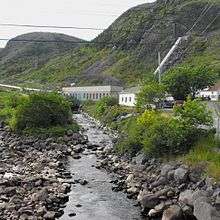Petty Harbour Generating Station
The Petty Harbour Hydro Electric Generating Station is a hydroelectric generating station in Petty Harbour–Maddox Cove, Newfoundland and Labrador. It was constructed in 1898 and it was the first hydroelectric generating station in Newfoundland.[1] It was built by the St. John's Street Railway Company, a company established by Robert Reid. Operation commenced on 19 April 1900.
_(14773991525).jpg)

In 1920 Reid renamed the company the St. John's Light and Power Company. On 7 February 1921, an avalanche destroyed 23 m (75 ft) of the wooden penstock that carried water from the dam to the generating station, cutting off all electrical power to St. John's for almost five days.[2] Then, in 1924, the plant changed ownership to the Royal Securities Corporation of Montreal, where they began extensive reconstruction of the plant and watershed area.
On 1 May 1978, the plant was entered in the Canadian Engineering Heritage Record as a model reflecting progressive adaptation to emerging technology, and remains today as one of the few plants of its type still in active service.
General Information
Location: Petty Harbour-Maddox Cove, Newfoundland and Labrador
Owner: Newfoundland Power
Capacity: 5.3 MW
Average Yearly Output: 18 gigawatt-hours
Head: 57.9 metres
Average Streamflow: 5.6 cms
On-Line: 1900
Original Design: G.H. Massey, A.C. Rice
Original Construction: Reid Newfoundland Company
Equipment
Turbines
Unit 1: (installed in 1902)
Inward-flow Girard type (impulse turbine)
1.4 MW
Manufactured by Stillwell, Bierce & Smith
Vaille Co.
Replaced in 1912 with
Horizontal Francis turbine
1.57 MW
Manufactured by Voith
Unit 2: (installed in 1900) Victor type (early Francis turbine)
1.4 MW
Manufactured by Stillwell, Bierce & Smith
Vaille Co.
Replaced in 1908 with
Horizontal Francis
1.57 MW
Manufactured by Voith
Unit 3: (installed in 1926) Horizontal Francis 2.05 MW Manufactured by Armstrong Whitworth
Generators
Unit 2 (installed in 1900):
3-phase, 60 Hertz, 550 volts
Manufactured by Westinghouse
Replaced in 1926 with
3-phase, 60 Hertz, 2,300 volts
Manufactured by General Electric
Unit 1 (installed in 1902):
3-phase, 60 Hertz, 550 volts
Manufactured by Westinghouse
Rewound in 1926 to 2,300 volts
Unit 3 (installed in 1926):
3-phase, 60 Hertz, 2,300 volts
Manufactured by General Electric
Construction
Powerhouse
48.8 metres long by 7.3 metres wide by 4.9 metres high Masonry construction
Penstock
Original:
1,057 metres long, 2.4-meter by 2.4-meter
cross-section wooden flume
112.2 metres long, 2.4-meter by 2.4-meter
cross-section rock tunnel
115.2 metres long, 2-meter-diameter
steel penstock
Replacements:
1926: 975-metre-long, 2.3-meter-diameter
wood stave penstock
1953: Steel penstock (surge tank riser)
replaced with 2.3-metre-diameter
steel pipe
1999: Lower 740.7 metres of penstock
replaced with 2.3-metre-diameter
steel pipe
Intake Structure:
Concrete with steel gate and lift
(integral to forebay dam)
Dams & Reservoirs
Forebay
In 1900, rockfill with timber facing. Replaced in 1926 with concrete gravity. Steel anchors added in 1992. 9.1-meter maximum height.
Bay Bulls Big Pond
Zoned earthfill (rebuilt 1998-1999) Concrete outlet conduit
Cochrane Pond
Earthfill with concrete overflow spillway and timber crib outlet
Tailrace
Unlined canal excavated in rock 137 metres long
References
- McBride, Michelle. "Hydro Development in Newfoundland and Labrador". Memorial University of Newfoundland. Retrieved 2009-01-21.
- "Petty Harbour Hydro-Electric Generating Station". Canada's Historic Places, Administered by Parks Canada. Retrieved 2011-04-11.